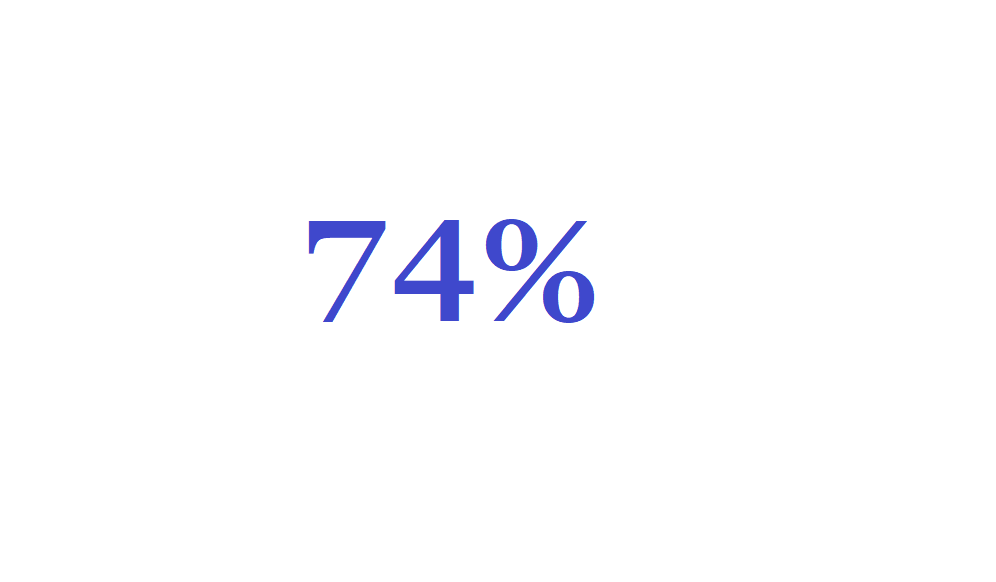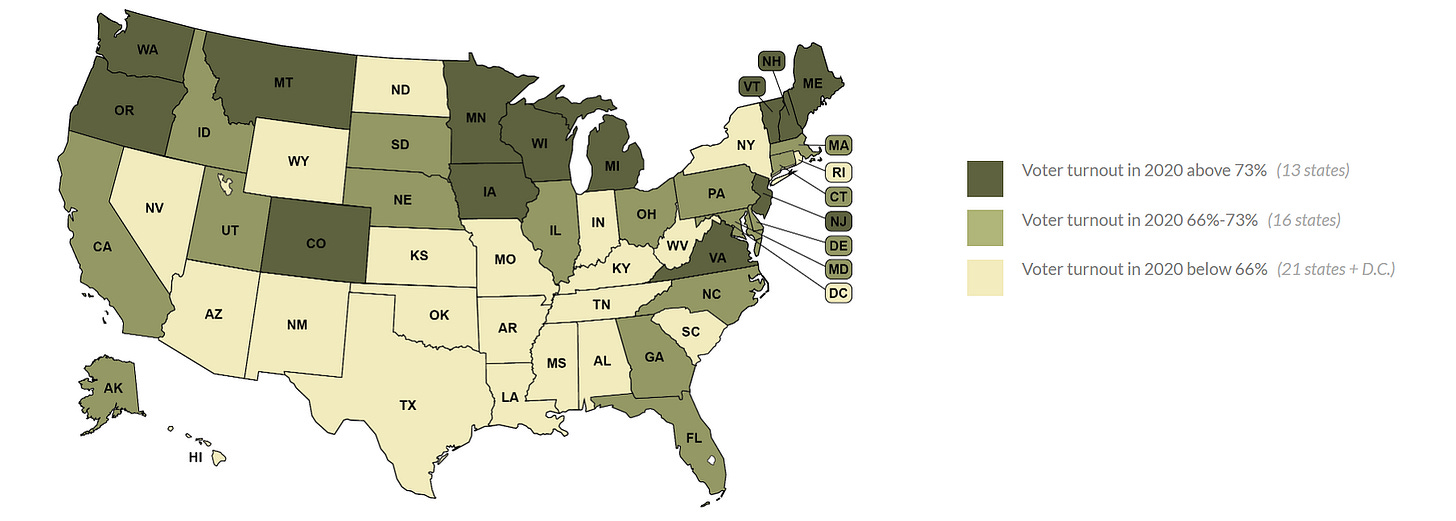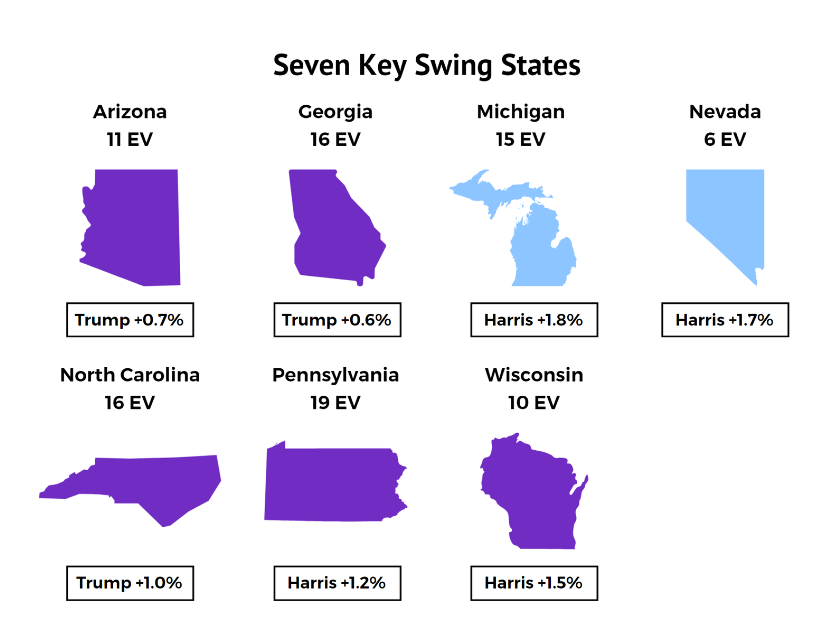The number you see above, 74%, represents the voter turnout rate for the 2020 Presidential election in Michigan. This is a substantial 8% higher than the national average for that year.
Of the 13 states with above-average voter turnout, 11 are states that regularly vote for Democrats. There are several reasons for this, but two key factors significantly drive the higher turnout rates:
Voting is made more convenient for voters.
These states have a higher proportion of college-educated voters.
The national average for educational attainment, currently at 53.7%, is largely influenced by Democrat-run states. In fact, the top ten states in terms of educational attainment are all Democratic-leaning. The entire top ten list includes D.C., Massachusetts, Maryland, Vermont, Colorado, New Jersey, Connecticut, Virginia, New Hampshire, and Washington. These blue states help elevate the national average.
Both Michigan and Wisconsin slightly trail the national average for educational attainment, by around 2 to 3 percentage points. These states also have a sizable white population:
Michigan: 75%
Wisconsin: 81%
This is one of the main reasons these two states remain competitive battlegrounds. There are enough white voters and voters without a college degree to attract Republican interest, while the presence of college-educated voters and women makes them appealing to Democrats. The latter group tends to have higher voter turnout, which often helps push Democrats over the finish line.
In the 2020 presidential election, Donald Trump lost Michigan by approximately 154,000 votes and Wisconsin by about 20,000 votes. In that cycle, pollsters missed the mark by a significant margin in both states, predicting Biden to be ahead by around 8 points. That didn’t happen, and not many criticized the pollsters because Biden won. However, the final margin was much narrower than what the polls suggested.
Pollsters did underestimate Donald Trump’s strength in 2020. Although he lost, they clearly missed the mark. Now, after their poor track record in the last two presidential cycles, it seems they might be overcompensating by overstating Trump’s support this year. No recent poll shows any significant defection from the GOP for Trump. Poll after poll shows Trump maintaining 90 to 95% Republican support — higher than what he received in 2020.
To claim that his Republican support increased after the insurrection, his felony cases, and the Dobbs decision defies reality. Who are the voters who backed Liz Cheney in her Wyoming GOP primary against Trump’s candidate? Where are the voters who supported Nikki Haley for the GOP presidential primary?
This is a key factor that leads me to deduct one to two points from Donald Trump’s polling numbers in some states.
The second issue I’m particularly cautious about is placing too much emphasis on a single poll. For example, the Quinnipiac poll released on October 8th showed Trump leading in Michigan by 4 points. Just one day later, a poll by Research Co. had Harris ahead by 3 points. As usual, the entire GOP and the media fixated on the Quinnipiac poll, as they tend to do.
But we can’t — and shouldn’t — do the same.
The same pattern occurred in Wisconsin. Quinnipiac had Trump ahead by 2 points on October 8th, and the very next day, Research Co. had Harris leading by 2 points.
So, let’s keep a level head and rely on aggregated data for a clearer picture. I personally prefer the model built by Racetowh. Here’s a screenshot of the battleground status I took from them on October 10th.
I believe Harris is stronger than the current polling suggests in Michigan, Wisconsin, and Pennsylvania, while Trump appears to be outperforming his polling numbers in Nevada, Arizona, and Georgia. Harris is making progress with Latino voters, but she’s not quite where she needs to be yet.
A recent Mason-Dixon/Telemundo CA Hispanic poll had Harris at 55% and Trump at 33%. Trump is at a level where you want him with Hispanic voters — below 35%. However, Harris needs to get closer to 60%, ideally at least 58%. She’s currently offsetting this shortfall by building a large lead with college-educated voters, which explains why her lead hasn’t stretched beyond 2 points in the Sun Belt or more than 4 points in the Midwest.
Still, between the two campaigns, you’d rather be in Harris’s position. Her campaign is leading, and they have a solid financial cushion to keep Trump in check.
One of the biggest challenges Harris faced when she became the Democratic nominee was raising $1 billion — that was the top criterion on my list. She entered the race late, with Trump already ahead in the polls. If she hadn’t met that fundraising goal, her chances of winning would have dropped significantly.
But she’s done it. The Harris campaign has hit the $1 billion mark but is hesitant to release the September fundraising numbers, fearing it could lead to donor complacency in the final stretch. Honestly, they need to let go of that fear. Democracy is worth more than a billion dollars, and people will recognize the threat they face.
Trump spread misinformation during COVID, and now he’s doing it again with disaster relief. Those supporting Harris do not want four more years of misinformation on steroids. So, Team Harris, be bold. Release the fundraising numbers, and keep investing in getting out the vote. Take that media cycle, however short it might be. No need to keep giving Trump more oxygen.







Very clear calls! And that web site is indeed powerful.